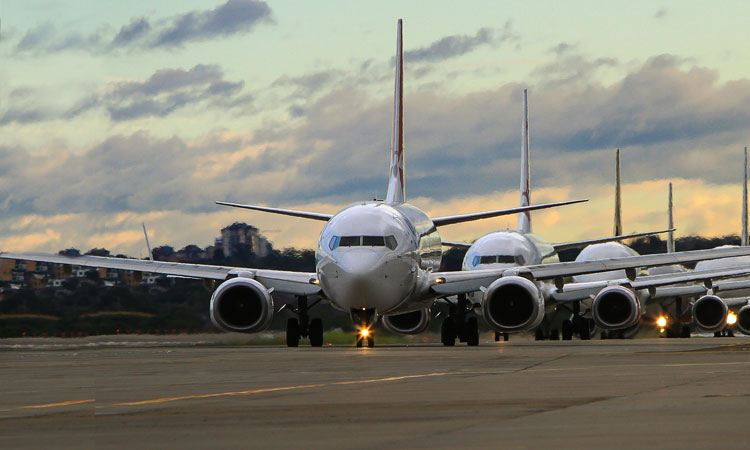Delivering an efficient and sustainable air traffic flow
- Like
- Digg
- Del
- Tumblr
- VKontakte
- Buffer
- Love This
- Odnoklassniki
- Meneame
- Blogger
- Amazon
- Yahoo Mail
- Gmail
- AOL
- Newsvine
- HackerNews
- Evernote
- MySpace
- Mail.ru
- Viadeo
- Line
- Comments
- Yummly
- SMS
- Viber
- Telegram
- Subscribe
- Skype
- Facebook Messenger
- Kakao
- LiveJournal
- Yammer
- Edgar
- Fintel
- Mix
- Instapaper
- Copy Link
Posted: 21 September 2021 | Coleen Hawrysko | No comments yet
Air traffic flow management and collaborative decision-making are key drivers of efficient aviation. Balancing demand against capacity and increasing operational coordination, they are critical procedures for air navigation service providers, airlines and airports in delivering synchronised, seamless and sustainable air transport, says Coleen Hawrysko, Operations Programme Manager at CANSO.


If the past year has taught us anything, it’s that, as an industry, we need to be ready for anything, whether that’s rapid changes in demand or extraordinary events which challenge day-to-day operations. Flexible traffic flow and collaborative working are key to this, helping to ensure a safe, seamless and sustainable service across the aviation value chain. Air traffic flow management (ATFM) and collaborative decision-making (CDM) principles are therefore helping aviation to unlock network potential and future-proof performance.
In the past 12 months, we have all learned the importance of adapting and working together to overcome adversity, and aviation is a prime example of this. As the world locked down and movements reduced, the aviation industry had to pivot, grounding some operations while working hard together to keep others – repatriation and essential journeys, and the transport of vital goods and services – moving freely and securely.
This has not only been a complete change in trajectory following decades of rapid growth in passenger travel, but also a reminder of how the industry must be agile and responsive to a variety of factors.
In the short-term, this is vital for tackling a volatile traffic picture and, in the longer term, to building a smarter, more sustainable transport network.
Efficient flow management is a key component of safe and seamless skies. It helps the industry to identify and navigate potential operational issues and maintain a seamless service. It also brings aviation partners together to coordinate on matters affecting the network and jointly determine a response.
Flow management and the processes that facilitate it are, therefore, a powerful example of how the industry is approaching its new future, collaborating to optimise operations and provide a flexible service.
Power of partnership
When it comes to managing air traffic flow, ATFM and CDM are the two critical procedures that underpin an effective, coordinated approach.
ATFM helps aviation partners to monitor demand, capacity and constraints at airports and in airspaces, enabling stakeholders to share accurate and up-to-date information and make appropriate decisions, accounting for all stakeholder requirements.
CDM is the principle that drives ATFM strategy, encouraging the sharing of all relevant information among decision-makers and supporting ongoing dialogue between the various stakeholders throughout all phases of flight. Airport Collaborative Decision Making (A-CDM) facilitates the efficient turnaround of aircraft at airports, improving operational efficiency for all airport stakeholders.
When implemented effectively, these processes ultimately enable efficient joint decision-making based on accurate and high-quality information. This information decreases flying times; reduces airborne holding; limits radar vectoring and routings; and minimises speed control, ground delays and congestion on the ground.
Stakeholders, including airports and airlines, benefit significantly from the increased predictability and punctuality and optimised resources. Such global interoperability helps to deliver safe, efficient and cost-effective air transport.
Driving innovation
The air traffic management (ATM) industry plays an important role in devising, delivering and upholding effective ATFM/A-CDM and CDM procedures and principles alongside other stakeholders.
As the voice of the ATM industry, the Civil Air Navigation Services Organization (CANSO) is helping to power these cross-industry partnerships and shape our skies.
CANSO comprises a network of air navigation service providers (ANSPs) and industry suppliers worldwide, which work together to share knowledge and expertise, and with industry stakeholders to help to deliver a seamless service.
A key part of this has involved developing guidance material on implementing best practice and enhancing operational performance. This includes ‘Implementing Air Traffic Flow Management and Collaborative Decision Making’ and the ‘CANSO Guide on ATFM/A-CDM Integration’.
CANSO has also delivered a series of education and development sessions and collaborative events to explore common challenges and practical solutions, including integration (with Airports Council International (ACI)) and performance analysis.
Beyond this, CANSO has also been leading by example, delivering flagship ATFM/CDM projects that showcase powerful partnerships, regional delivery and innovation.
Regional focus
In 2016, CANSO launched CADENA (the CANSO ATFM Data Exchange Network for the Americas), an initiative to promote and facilitate the safe and efficient movement and harmonised flow of air traffic in the Latin America and Caribbean region through ATFM and CDM. The group comprises ANSPs, airlines, industry associations and stakeholders.
Initially developed to help to streamline aviation activities in a rapidly growing air transport region, CADENA has delivered a myriad of benefits for the regional aviation community.
By aggregating and sharing key aviation data, CADENA has been pivotal in helping to navigate natural disasters – such as Hurricane Delta, which hit the region in October 2020 – optimise routes through a direct routing initiative and overcome network-level technical issues by offering essential coordination on contingency procedures. More recently, CADENA has been supporting the safe transport of vital vaccines across the region, and is set to enable coordination with the U.S. Federal Aviation Administration (FAA) Air Traffic Organization Space Operations to facilitate the safe and efficient movement of space launch and recovery operations.
The benefits of ATFM and A-CDM are also being harnessed in Africa, where the CANSO Mombasa ATFM Roadmap has brought together industry key players from across the region to develop a framework for managing fluctuating air traffic demand and the rise of new airspace users based on ATFM and CDM principles. Established in 2018, the initiative is seeking to harmonise ATM operations and deliver vital coordination for all aviation stakeholders.
In Asia-Pacific, the Northeast Asia Region ATFM Hamonization Group (NARAHG) and the Asia Pacific Cross-Border Multi-Nodal ATFM Collaboration (AMNAC) have been leveraging their networks to share key aviation information and build a regional outlook during the COVID-19 pandemic. This reliable flow of information has also enabled AMNAC to develop a digital information exchange model to support system-wide information management (SWIM), building a better and more resilient regional network.
Global opportunities
Building on its expertise and global success stories in shaping global air traffic flow, CANSO is aiming to work with aviation partners worldwide on ATFM and CDM implementation. The vehicle for this is a new purpose-built collaborative software platform called CADENCE.
CADENCE will be made available in all regions, supported by CGH Technologies, including the developer of the CADENA platform. It will enable ANSPs to share information on factors affecting airspace demand and capacity; facilitate enhanced situational awareness; and bolster stakeholder engagement on collaborative approaches to air traffic optimisation across the globe.
This initiative is a key step for the industry in achieving global harmonisation of operations, enabling ANSPs, airlines and other stakeholders to effectively work together to reduce air traffic delays, lessen the environmental impact and improve collaborative planning on everything from runway construction to the management of air traffic following natural disasters.
Operational efficiency
Flow management best practice is just one of the measures that the ATM community is developing to deliver operational efficiencies during restart and recovery and beyond, but its benefits are the building blocks upon which aviation can grow.
By supporting more efficient aviation, ATFM/A-CDM and CDM are helping to provide flexibility and resilience, as well as fertile ground for other operational best practice initiatives to thrive. They are also helping to bring the industry together, uniting regional communities around common challenges and objectives, and strengthening an industry that, together, has the power to efficiently and effectively channel the vital flow of people, goods and services around the globe once again and deliver much-needed social and economic benefits.


Issue
Related topics
Air traffic control/management (ATC/ATM), Airport Collaborative Decision Making (A-CDM), Passenger experience and seamless travel, Sustainability


















